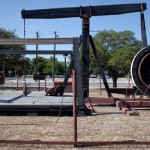More Than Their Fair Share? Texas County Questions Frack Water Disposal Wells

Dave Fehling / StateImpact Texas
Tanker trucks arrive at the disposal well that was site of a 2012 explosion. It's approved to inject 30,000 barrels of wastewater a day.
Some people who live in Pearsall, the South Texas town where country star George Strait grew up, said they learned they had a disposal well nearby when they heard a big boom.
“Then I saw the billows of smoke coming out,” said Henry Martinez, Pearsall’s police chief.
He’s talking about the afternoon in January 2012 when investigators say a welder’s spark ignited oil vapors at a disposal site on the edge of town.Three workers were hurt and OSHA later cited the operator for alleged violations and proposed a $46,200 penalty.

Courtesy Pearsall Volunteer Fire Dept.
Fire at disposal site near Pearsall Jan. 19 2012
What’s a Disposal Well?
The explosion became just one of many concerns local officials began to confront as they learned more about disposal wells.
“It was brand new to me, I don’t have any knowledge of oil and gas,” said Pearsall’s mayor, Albert Alvarez.
The site of the explosion was just one of at least eight commercial disposal operations in Frio County. Operators are seeking more state permits to open new sites as drilling continues to surge in the Eagle Ford Shale.
Disposal wells are in big demand. They take the wastewater that results from drilling oil and gas wells. There’s now over 3 billion barrels of the water generated annually statewide, a mix of naturally-occurring saltwater plus the water used in the hydraulic fracturing process. It can contain chemicals as well as hydrocarbons. The Railroad Commission of Texas requires the water be injected in disposal wells that the commission oversees.
There have been concerns over what threat the wastewater poses to groundwater supplies and in North Texas, disposal wells have been linked to minor earthquakes. In Pennsylvania where gas well drilling has also surged, some of the wastewater is being trucked to Ohio. Meanwhile, lawmakers in New Jersey passed a bill banning out-of-state frack water from coming into the Garden State but the bill was later vetoed.
A study by the Pacific Institute found that frack water disposal may emerge as one of the most significant water pollution issues related to fracking.
“As we start talking about ramping up domestic oil and gas production to levels we haven’t seen, we need to really think about what the implications are,” said Heather Cooley, a water researcher at the institute.
More than Fair?
The problem in Frio County is that officials feel the county has more than its fair share of disposal wells. Unlike the nearby counties of Karnes, Gonzales, and La Salle that are among the top oil producers in Texas, Frio County isn’t. But it has more disposal wells than those three counties combined according to Railroad Commission records.
“We’re out of whack,” said Richard Graf, a Frio County Commissioner. “Now we’ve taken the lead and we’re protesting some of these permits.”

Dave Fehling / StateImpact Texas
Carlos Garcia is the Frio County Judge
The Frio County Judge, Carlos Garcia, has been working with state lawmakers on ways to compensate the county through a penny-a-barrel fee on disposed wastewater. Garcia estimates the fee could bring in upwards of a million dollars a year and would go to a fund in case of environmental damage.
Garcia also pitched the idea of giving the county more power over where wells could be located.
‘If we would have that control, we could decide where the wells would be. We would have the control over the land, which we don’t. We don’t have zoning powers in our county,” said Garcia. He added that so far, he has had no luck finding support among lawmakers for the granting of such power to a county government.
Why Frio?
Some Frio County officials have had their suspicions as to why their county has become “disposal well central,” suggesting it was because they hadn’t been more aggressive in fighting to block the sites from getting permits. But one long-time drilling consultant said it’s simply a matter of geology.
“When you get up in Frio County, those sands are bigger and can hold a lot more water,” said Charles McClain who talked to StateImpact on his cellphone from a disposal site near the town of Dilley in southern Frio County.
McClain explained that those underground sand formations are environmentally favorable for absorbing the huge quantities of wastewater and are unique to the Frio County area. He says that’s why more disposal sites are located there than in other counties.
“The people that don’t understand how the deal works. They think for some odd reason they’re just coming up to Frio County to drill the disposal wells,” McClain said.
As to the danger of explosions like the one last year near Pearsall, McClain said it’s a risk around any oil or gas operation but that at disposal wells the damage from an explosion would be limited as long as the sites were away from populated areas. The explosion in Pearsall was about one mile from the town’s nearest residential street.
“There’s no way it could ever blow up and blow the whole town down,” said McClain.
One way to reduce the amount of polluted water needing disposal is to recycle it. The Railroad Commission recently adopted new rules for recycling frack water.

